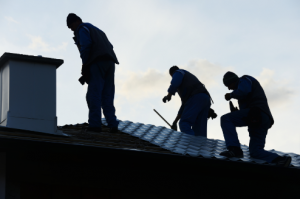How to Prepare Your Home for a Local Roof Replacement
In this article, we will guide you through the essential steps to prepare your home for a local roof replacement, ensuring a smooth and efficient process. Replacing a roof is a significant investment and involves multiple phases, from planning to execution. By taking the time to prepare accordingly, you can help facilitate a quicker turnaround and ensure the safety of both your home and the crew working on the project.
What to Do Before the Roofing Crew Arrives
Clear Your Yard and Driveway
Ensuring your yard and driveway are free from vehicles and miscellaneous items is crucial. This step not only protects your property from potential damage but also allows the roofing crew to have full access and mobility around your home. By providing a clean and organized work area, you make the crew’s job more efficient and potentially reduce the time it takes to complete the project.
Outdoor furniture and decorative items can be vulnerable during a roof replacement. These items might be in the direct path of falling debris or could get in the way of essential equipment and materials. Therefore, relocating them can help prevent unintentional damage and make the job site safer for all involved.
Notify Your Neighbors
Good neighborly relations are essential, and a large project like roof replacement can disrupt the usual peace of the neighborhood. Informing your neighbors of the scheduled work can mitigate irritation from unexpected noise and activity. They’ll appreciate being prepared, particularly if your home is close to theirs or if they have specific needs or concerns, such as light sleepers or pets.
Communication helps in setting realistic expectations regarding noise levels, the location of workers, and the start and end times each day. Notifying your neighbors provides them with an opportunity to make adjustments, such as re-parking vehicles or planning out-of-home activities. This mutual respect goes a long way in maintaining positive relationships during and even after your construction project.
How to Protect the Inside of Your Home During Roof Replacement
Protect Interiors from Dust and Debris
During a roof replacement project, there is a high likelihood that dust and debris will infiltrate your home’s interior spaces. Although the roofing contractor will take precautions to keep this under control, it’s always wise to take additional steps yourself. Covering furniture, electronics, and valuable items with drop cloths or plastic sheeting can prevent damage or dirt accumulation.
While the construction is ongoing, vibrations can travel through the structure of your house, causing dust to be shaken loose from light fixtures and structural joints. As a precaution, consider using tape or cloth to seal the seams of doors and air vents. By taking steps like these, you keep your interior cleaner and reduce the risk of damage, making post-project cleanup easier.
Safeguard Your Attic
The attic is particularly vulnerable during a roof replacement due to its proximity to the roof structure. Significant vibration from roof work can dislodge items stored in this space or expose them to debris. It’s wise to either temporarily relocate valuables or cover them securely with protective materials such as tarps to minimize the risk of damage.
Identifying particularly valuable or fragile items stored in the attic and moving them to a safer location in the home is also advisable. You might also consider organizing this space before the work begins to make it easier to secure items and ensure nothing is forgotten amid clutter. By preemptively addressing potential issues, you maximize protection and save yourself from bothersome surprises and damages post-work.
How to Ensure a Smooth Roof Replacement Process
Communicate with the Roofing Contractor
Open, continuous communication with the roofing contractor is key to a successful roof replacement project. Before the work begins, discuss your needs, set expectations, and address any specific concerns with the project manager or lead contractor. Regular updates, whether in person, via phone, or through email, ensure you are informed and can resolve potential issues promptly.
The roofing contractor may also have specific requests or preparatory steps they recommend for your particular scenario. Clear communication will help you understand their requirements and collaborate effectively, optimizing the job flow. Maintaining good communications throughout the project timeline contributes to a successful outcome, setting you up to avoid misunderstandings or delays.
Understand the Project Timeline
Getting familiar with the project timeline is critical to managing expectations and planning your activities accordingly. Discuss with the contractor to get a clear understanding of how long each stage of the roof replacement will take, giving special consideration to potential weather delays. This knowledge helps you coordinate any adjustments you might need to make, such as alternate accommodations or activity planning during the construction phase.
Combined with regular updates, knowing the timeline helps you monitor project progress and identify any deviations early on. By staying on top of timings and knowing what to expect next, you can remain proactive in addressing any concerns. Knowing these details ahead of time allows you to have meaningful discussions with the crew about any changes that may affect the agreed schedule.
By following these preparatory steps, you’ll be well-equipped to handle the challenges of a local roof replacement, ensuring safety and efficiency throughout the process. Taking the time to clear your outdoor space, communicate with both neighbors and contractors, and protect the interior of your home will pay off significantly, minimizing potential disruptions or damages. A well-prepared home allows roof workers to complete the job successfully and with fewer unforeseen complications, ultimately contributing to a longer-lasting, robust roofing solution.









